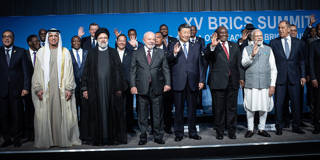JIM O'NEILL

LONDON – When I coined the BRIC acronym back in 2001, my primary point was that global governance would need to adjust to incorporate the world’s largest emerging economies. Not only did Brazil, Russia, India, and China top the list of that cohort; they also were collectively responsible for governing close to half of the world’s population. It stood to reason that they should be represented accordingly.
Over the past two decades, some have misread my initial paper as a kind of investment thesis, while others have interpreted it as an endorsement of the BRICS (South Africa was added in 2010) as a political grouping. But I never intended any such thing. On the contrary, ever since the Brazilian and Russian foreign ministers proposed the idea of creating a formal BRIC political grouping in 2009, I have questioned the organization’s purpose, beyond serving as a symbolic gesture.
Now that the BRICS has announced that it will add six more countries – Argentina, Egypt, Ethiopia, Iran, Saudi Arabia, and the United Arab Emirates – I pose the question again. The decision, after all, does not appear to have been decided on any clear objective, much less economic, criteria. Why, for example, was Indonesia not asked? Why Argentina and not Mexico, or Ethiopia and not Nigeria?
Clearly, the BRICS’ symbolic power will grow. The group has been able to tap into the broader Global South’s suspicion that post-World War II global-governance organizations are too Western. It has occasionally been able to present itself as the voice of the emerging and developing world – a category that of course excludes the United States and other advanced economies. Insofar as it has reminded everyone that the structure of international institutions does not reflect the global economic shifts over the past 30 years, it has succeeded.
It is true that in terms of purchasing power parity, the BRICS are slightly larger than the G7. But, because their currencies trade at prices far below their PPP-implied levels, the group remains significantly smaller than its advanced-economy counterpart, when measured in current nominal US dollars.
It is also true that China has firmly established itself as the world’s second-largest economy. In nominal terms, its GDP is more than three times larger than Japan and Germany, and around 75% the size of the US. Meanwhile, India has been growing fast and now seeks to become the third-largest economy by the end of this decade. But none of the other BRICS has performed anywhere near as well as these two. Brazil and Russia account for around the same share of global GDP as they did in 2001, and South Africa is not even the largest economy in Africa (Nigeria has surpassed it).
Of course, some G7 members are in the same boat. Italy and Japan have registered hardly any growth for many years, and the United Kingdom, too, has been struggling. Just as China dominates the BRICS by dint of being twice the size of all the others combined, so the US is now bigger than the rest of the G7 combined. America and China dominate their respective groups even more than they did in the past. What these dynamics suggest is that neither the G7 nor the BRICS (expanded or otherwise) makes much sense for tackling today’s global challenges. Neither can do much without the direct, equal involvement of the other.
What the world really needs is a resurrected G20, which already includes all the same key players, plus others. It remains the best forum for addressing truly global issues such as economic growth, international trade, climate change, pandemic prevention, and so on. Though it now faces significant challenges, it still can reclaim the spirit of 2008-10, when it coordinated the international response to the global financial crisis. At some point, the US and China will have to overcome their differences and allow the G20 to return to its central position.
As for the BRICS, the group could be more effective, on the margins, if key members were truly serious about pursuing shared goals. But China and India rarely agree on anything, and given their current bilateral relationship, neither is likely to be enthusiastic about the other gaining more influence in key global institutions (unless they are equally balanced).
That said, if China and India could resolve their border disputes and develop a closer constructive relationship, both countries would benefit, as would world trade, global economic growth, and the BRICS’ effectiveness. China and India could cooperate in many areas, and in ways that would influence the other BRICS and many others throughout the Global South.
One big issue is the dominance of the US dollar. It is not especially healthy for the world to be so dependent on the dollar and, as a corollary, on the US Federal Reserve’s monetary policy. The introduction of the euro could have diminished the dollar’s dominance if eurozone member states had agreed to allow their financial instruments to be liquid and large enough to appeal to the rest of the world. Similarly, if any of the BRICS – especially China and India – undertook significant financial reforms to achieve that goal, their currencies would almost certainly become more widely used. But if they continue to limit themselves to complaining about the dollar and musing in the abstract about a shared BRICS currency, they are unlikely to achieve much.
No comments:
Post a Comment